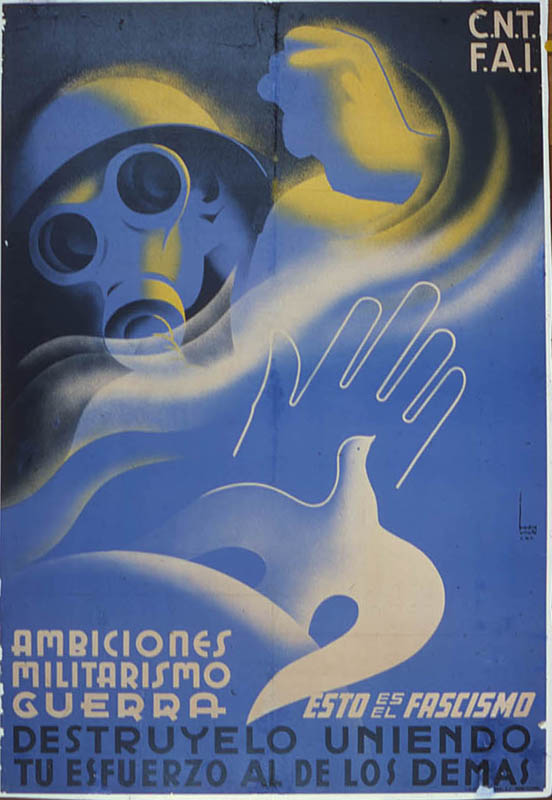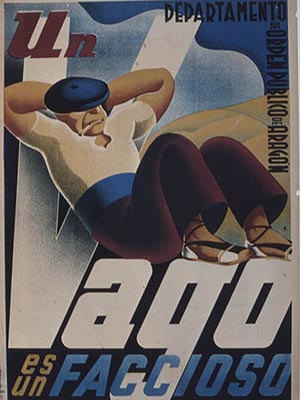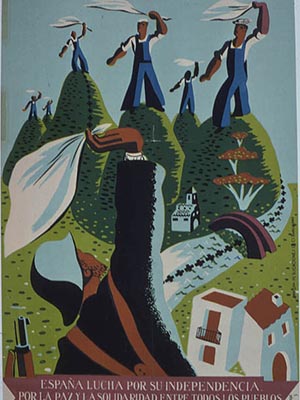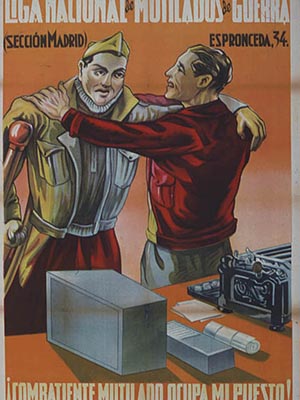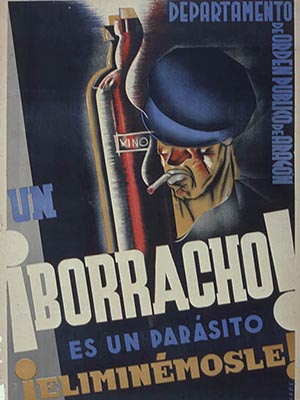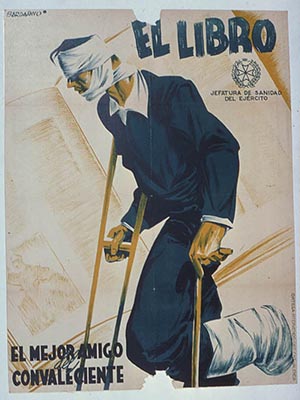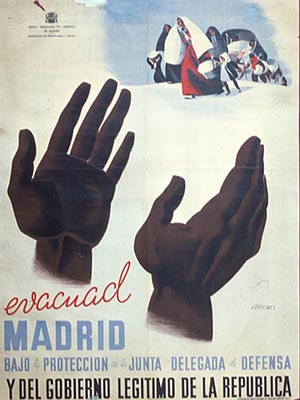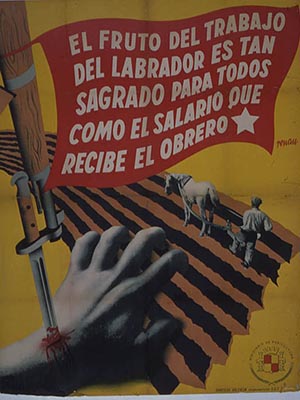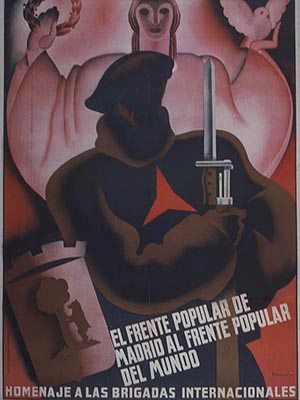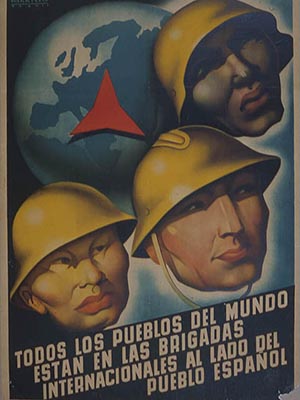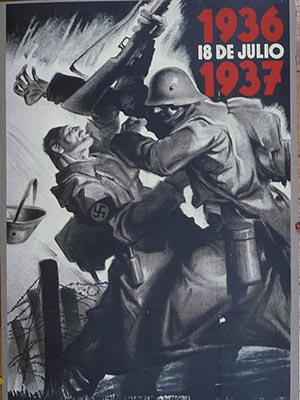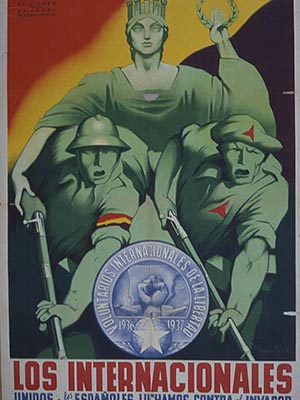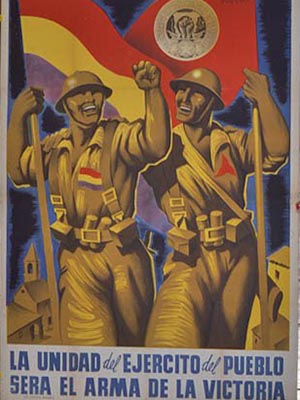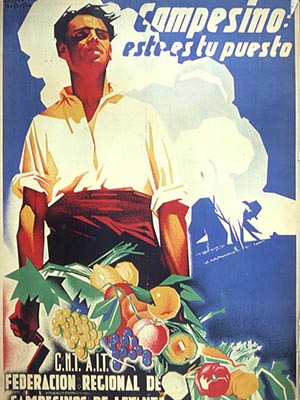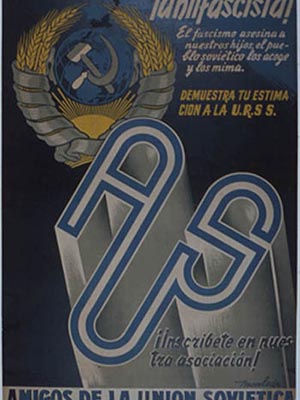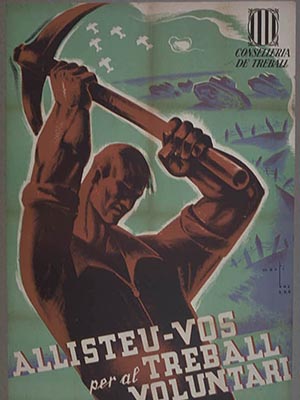Spanish Civil War Poster Collection
January 22, 2010
Brandeis University Special Collections holds a wide range of materials on the Spanish Civil War, a conflict that many historians consider to be the prelude to World War II. The Spanish Civil War began in 1936 with the far-right Nationalists’ attempted coup of Spain’s leftist, duly elected Republican government; it ended in 1939, after much bloodshed, with a Nationalist victory, Spain under the leadership of Franco and an alliance of right-wing Spanish political parties.
While much of the rest of the world maintained official neutrality during the conflict, the Nationalists received help from Hitler and Mussolini, which set the stage for the expansion of fascism throughout Europe. The Republicans were aided in their struggle by Stalin and Soviet forces, as well as by Mexico and by the interception of the International Brigades. The Brigades were composed of volunteers from other countries, including the U.S., who believed that the Spanish Republican government was the legitimate ruling power in Spain. During their time in Spain, members of the Abraham Lincoln Brigade sent or brought home to the U.S. the propaganda posters created for the Republican effort during the war. Brandeis’ Special Collections has preserved more than 250 such posters, which document a conflict that resonates to this day.
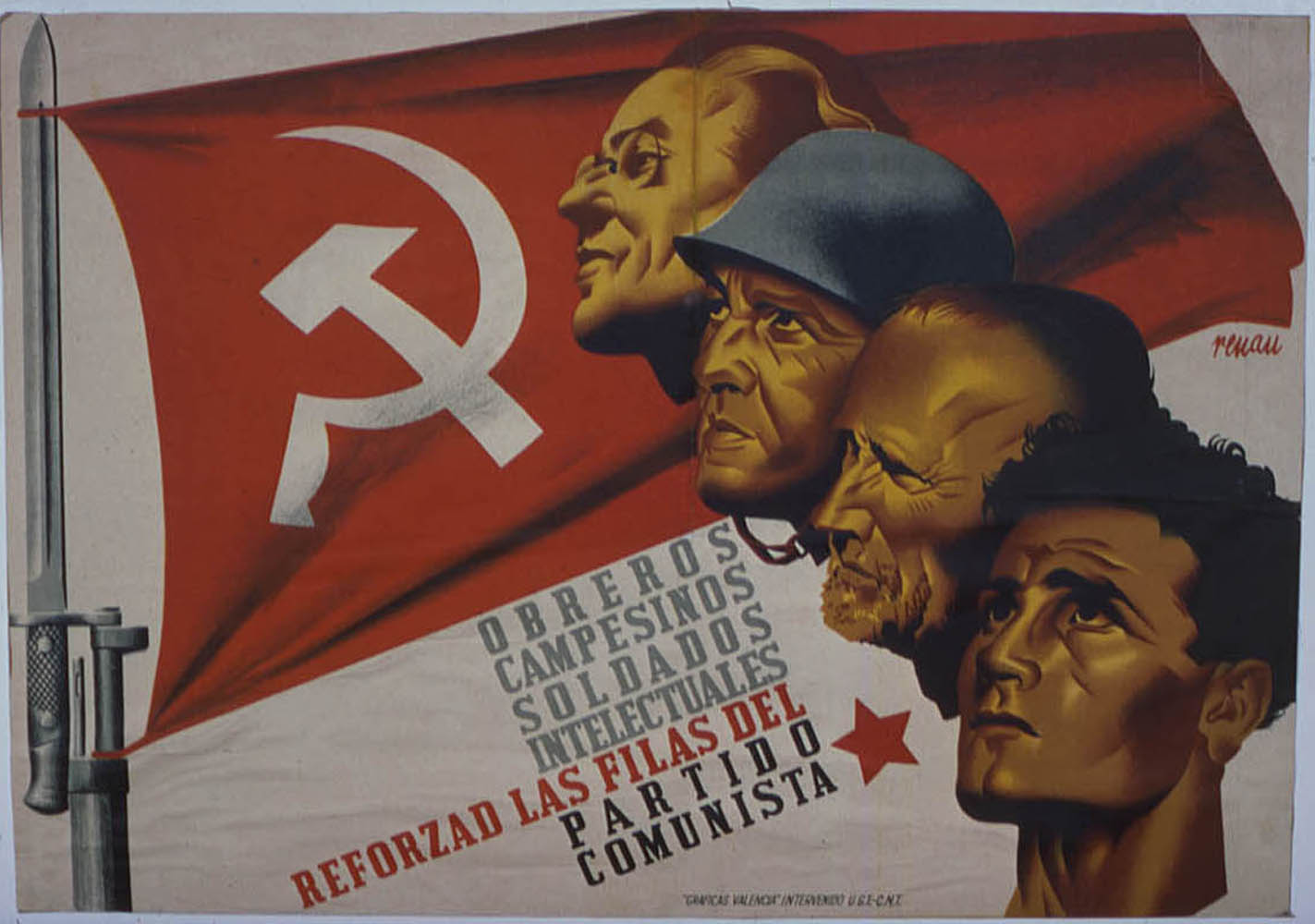 Like all posters, the Spanish Civil War posters in the Brandeis collection are public art with a focused agenda. These posters were meant to encourage support of and participation in the effort to resist a fascist takeover of Spain. Although other posters were created for commercial ends, these were created to serve a broader purpose, to make the viewer feel the importance of a strongly held belief—for thousands, a matter of life or death.
Like all posters, the Spanish Civil War posters in the Brandeis collection are public art with a focused agenda. These posters were meant to encourage support of and participation in the effort to resist a fascist takeover of Spain. Although other posters were created for commercial ends, these were created to serve a broader purpose, to make the viewer feel the importance of a strongly held belief—for thousands, a matter of life or death.
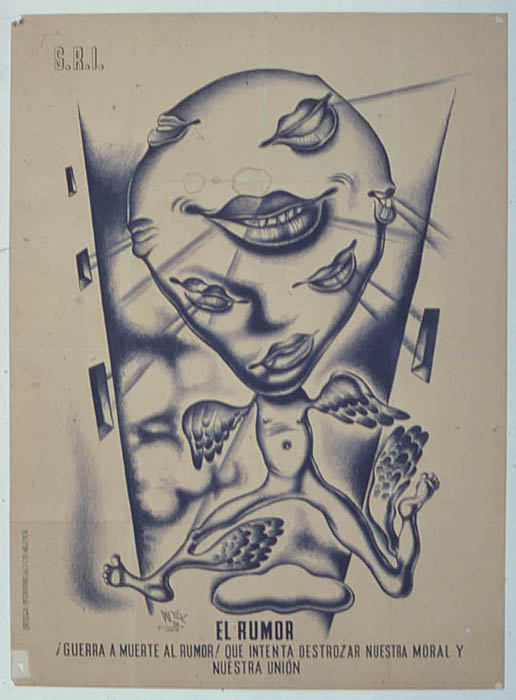 The artwork, by artists both known and anonymous, is striking in its boldness and style. Many of the posters were produced by artists in the Spanish Artists’ Union (SPBA). They used graphic, arresting images, sometimes shocking, for greatest effect: gas masks, bandaged soldiers, the symbols of fascism, wounded children, weapons of war. One cautionary poster, labeled “El Rumor” (by Ramón Puyol), depicts a winged being with eight mouths, soaring through the air. Another poster, by José Bardasano, commemorates one year of war with an image of a Republican soldier punching a soldier who wears a swastika, throwing him backward against barbed wire. A Catalonian poster (by Pere Catalá Roca) pictures a foot wearing a peasant's sandal stomping on a swastika. The use of vibrant color and bold lines conveys an urgency and immediacy suited to propaganda posters, which need to be easily seen and visually absorbed from a distance.
The artwork, by artists both known and anonymous, is striking in its boldness and style. Many of the posters were produced by artists in the Spanish Artists’ Union (SPBA). They used graphic, arresting images, sometimes shocking, for greatest effect: gas masks, bandaged soldiers, the symbols of fascism, wounded children, weapons of war. One cautionary poster, labeled “El Rumor” (by Ramón Puyol), depicts a winged being with eight mouths, soaring through the air. Another poster, by José Bardasano, commemorates one year of war with an image of a Republican soldier punching a soldier who wears a swastika, throwing him backward against barbed wire. A Catalonian poster (by Pere Catalá Roca) pictures a foot wearing a peasant's sandal stomping on a swastika. The use of vibrant color and bold lines conveys an urgency and immediacy suited to propaganda posters, which need to be easily seen and visually absorbed from a distance.
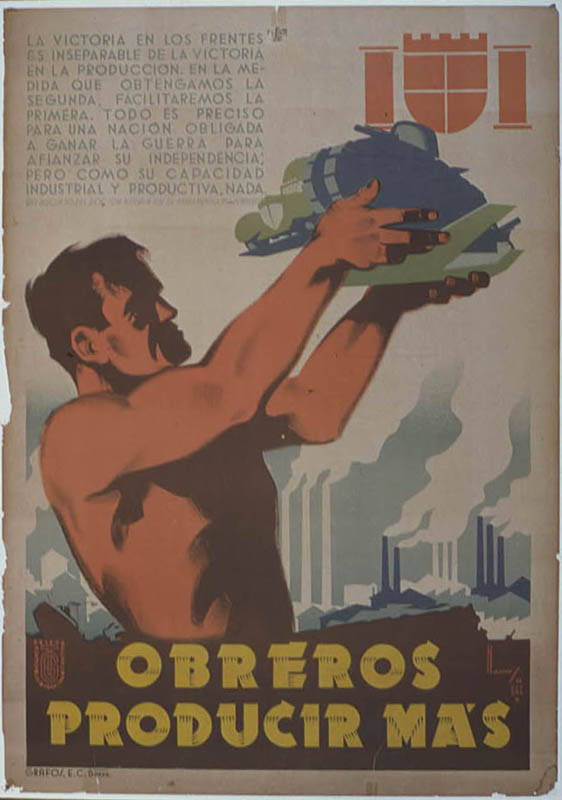
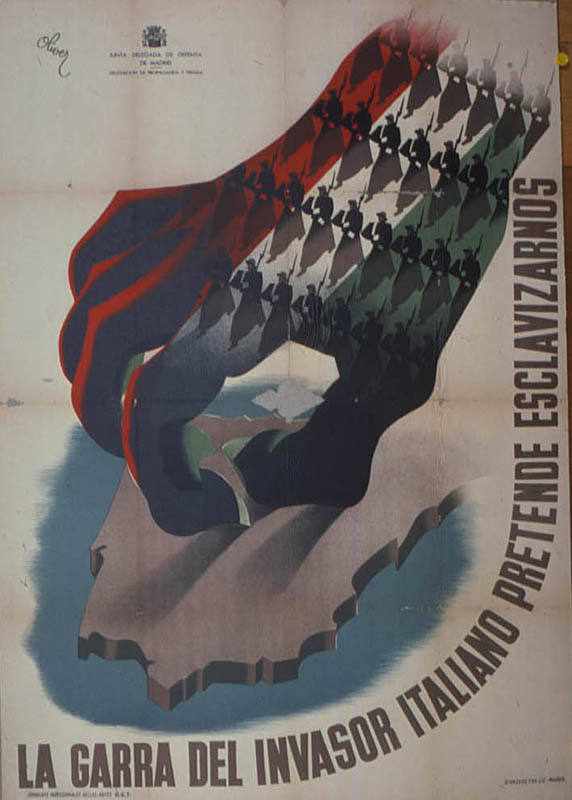 The messages of the posters, conveyed in both the artwork and the text (in either Spanish or Catalan), were delivered on behalf of government institutions, political parties, the international volunteer brigades, trade unions, youth organizations and other groups resisting the encroaching fascists. The posters emphasized the need to volunteer in the war effort, to fight fascism, to increase productivity in industry and agriculture, to care for children and the wounded, and to band together. One poster reads “Obreros de la Construccion: alistaos en los Batallones de Fortificacion” [Construction Workers: Enlist in the Fortification Battalions]. Another reads “La Garra del Invasor Italiano Pretende Esclavizarnos” [The Claw of the Italian Invader Grasps to Enslave Us]. Another, issued by the Aragon Department of Public Order, reads: “Un Vago es un Faccioso” [A Loafer is a Fascist]. Yet another says “Los Internacionales: Unidos a los Españoles, Luchamos Contra el Invasor” [The Internationals: United with the Spanish We Fight the Invader]. The messages changed as the war raged on and the demise of the Republican effort became clearer.
The messages of the posters, conveyed in both the artwork and the text (in either Spanish or Catalan), were delivered on behalf of government institutions, political parties, the international volunteer brigades, trade unions, youth organizations and other groups resisting the encroaching fascists. The posters emphasized the need to volunteer in the war effort, to fight fascism, to increase productivity in industry and agriculture, to care for children and the wounded, and to band together. One poster reads “Obreros de la Construccion: alistaos en los Batallones de Fortificacion” [Construction Workers: Enlist in the Fortification Battalions]. Another reads “La Garra del Invasor Italiano Pretende Esclavizarnos” [The Claw of the Italian Invader Grasps to Enslave Us]. Another, issued by the Aragon Department of Public Order, reads: “Un Vago es un Faccioso” [A Loafer is a Fascist]. Yet another says “Los Internacionales: Unidos a los Españoles, Luchamos Contra el Invasor” [The Internationals: United with the Spanish We Fight the Invader]. The messages changed as the war raged on and the demise of the Republican effort became clearer.
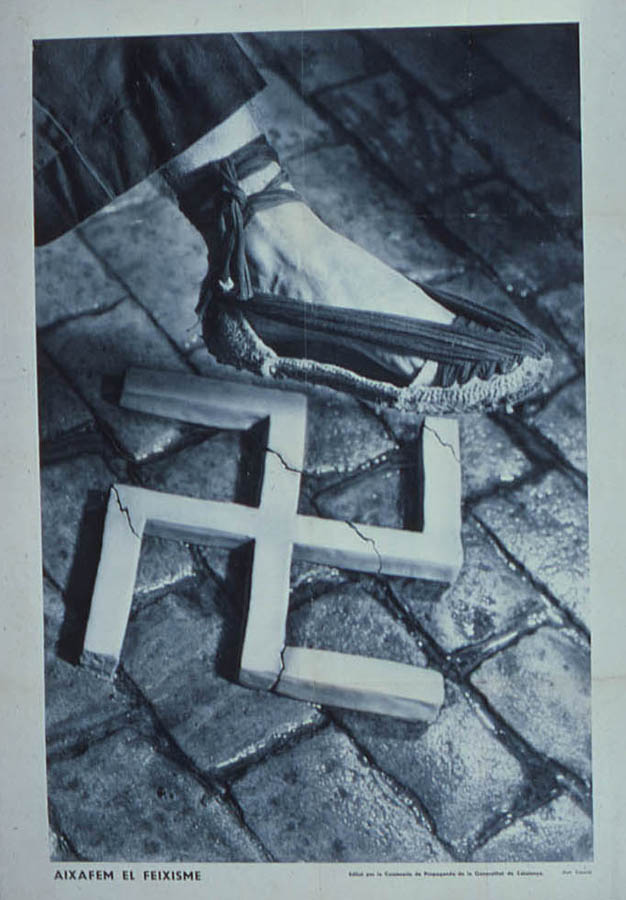 Despite their haunting imagery, urgent exhortations and ubiquity, the posters ultimately did not succeed in their aims. To see them today gives us a view not only of an art form put to use for an aim beyond art’s sake, but also of a tumultuous and tragic episode that formed a turning point of the 20th century.
Despite their haunting imagery, urgent exhortations and ubiquity, the posters ultimately did not succeed in their aims. To see them today gives us a view not only of an art form put to use for an aim beyond art’s sake, but also of a tumultuous and tragic episode that formed a turning point of the 20th century.
Spanish Civil War posters in Brandeis Distinctive Collections
Further Reading
Nelson, Cary. Shouts from the Wall: Posters and Photographs Brought Home from the Spanish Civil War by American Volunteers: A Catalogue to Accompany the Exhibit Curated by Peter Carroll and Cary Nelson for the Abraham Lincoln Brigade Archives. Waltham, Mass.: Abraham Lincoln Brigade Archives, c1996.
Tisa, John, ed. The Palette and the Flame: Posters of the Spanish Civil War. New York: International Publishers, c1979.
